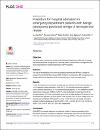Predictors for hospital admission in emergency department patients with benign paroxysmal positional vertigo: A retrospective review.
الملخص
This study aims to assess the incidence of Emergency Department (ED) visits for benign paroxysmal positional vertigo (BPPV), describe patient characteristics, management practices and predictors of inpatient admission of BPPV patients. This was a retrospective chart review of patients presenting with BPPV to a single ED between November 2018 and August 2020. Patients' characteristics, ED management, discharge medications, disposition and unscheduled return visits were determined. In total, 557 patients were included. Average age was 49 years, 54.2% were females and 12.4% required hospital admission. In the ED, 51.1% received intravenous hydration, 33.8% received anti-emetics, 10.1% received benzodiazepines, 31.8% underwent canalith repositioning maneuvers (CRMs) and 56.7% were discharged on acetyl-leucine. Of discharged patients, 2.5% had unscheduled return visits. A higher likelihood of admission was associated with age above 54 years (aOR = 4.86, p<0.001, 95% CI [2.67, 8.86]), home use of proton pump inhibitors (PPIs) (aOR = 2.44, p = 0.03, 95% CI [1.08, 5.53]), use of anti-emetics and benzodiazepines in the ED (aOR = 2.34, p = 0.003, 95% CI [1.34, 4.07]) and (aOR = 2.18, p = 0.04, 95% CI [1.03, 4.64]), respectively. While BPPV is a benign diagnosis, a significant number of patients presenting to the ED require admission. Predictors of admission include older age, PPIs use and ED treatment with anti-emetics and benzodiazepines. Although CRMs are the gold standard for management, CRMs usage did not emerge as protective from admission, and our overall usage was low.
المجموعات
- أبحاث التخصصات الصحية [123 items ]


